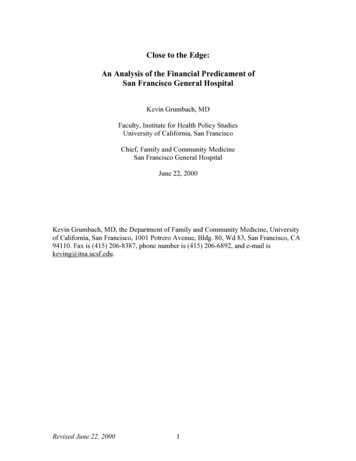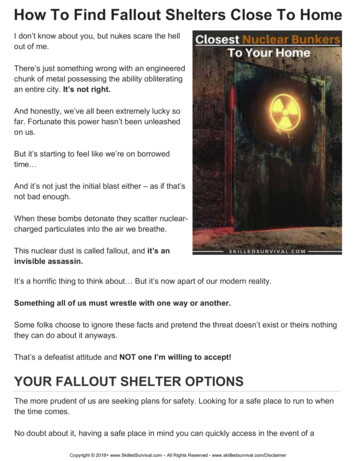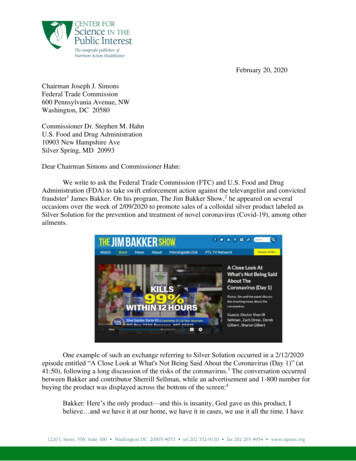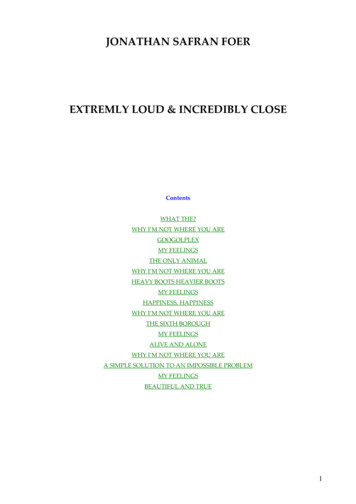
Transcription
Close to the Edge:An Analysis of the Financial Predicament ofSan Francisco General HospitalKevin Grumbach, MDFaculty, Institute for Health Policy StudiesUniversity of California, San FranciscoChief, Family and Community MedicineSan Francisco General HospitalJune 22, 2000Kevin Grumbach, MD, the Department of Family and Community Medicine, Universityof California, San Francisco, 1001 Potrero Avenue, Bldg. 80, Wd 83, San Francisco, CA94110. Fax is (415) 206-8387, phone number is (415) 206-6892, and e-mail iskeving@itsa.ucsf.edu.Revised June 22, 20001
AcknowledgmentsThe author thanks Ken Jensen and Monique Zmuda for providing data on SFGHexpenditures and revenues, and the Committee on the Changing Market, Managed Care,and the Future Viability of Safety Net Providers, Institute of Medicine, for their work indocumenting the broader national context of issues facing local safety net providers.The views expressed in this report are those of the author and not necessarily those of theinstitutions with which the author is affiliated.Revised June 22, 20002
Summary of Key Findings1. Costs at SFGH have risen more slowly than hospital costs for the nation overallduring the past decade. Annual SFGH expenditures increased from 205.0M in fiscal year 1989/1990 to 315.8M in 1999/2000, representing an average annual increase of 4.4%. During this same 10-year period, the annual average rate of increase in overallhospital expenditures in the US was 5.7%, a rate much greater than thatexperienced by SFGH. If expenditures at SFGH had followed national trends over the past decade,1999-00 expenditures would be 356.8M instead of the actual 1999/2000expenditures of 315.8M. Stated another way, adjusting for the national rate ofhospital cost inflation, in “constant 1989 hospital dollars” SFGH expendituresactually decreased from 205.0M in 1989 to 181.4M.2. State and federal policies have precipitated the local budget crisis in safety netfunding. Recent reductions in Medi-Cal revenues are the principal cause of thecurrent budget predicament at SFGH. Total net Medi-Cal revenues at SFGH have declined by 38.1M in the past 5years, from 157.2M in 1994/1995 to 119.1M in 1999/2000. This represents a24% decrease in Medi-Cal funds in nominal dollars (i.e., not adjusted forinflation). Reductions in Medi-Cal revenues are due to two principal factors : 1. A changein payer mix among inpatients at SFGH, with more uninsured patients and fewerMedi-Cal covered patients admitted to the hospital; this parallels the statewidegrowth in the number of uninsured persons and decline in the number of MediCal beneficiaries in California, and 2. Recent federal policy changes to reducefederal funding of the Medicaid Disproportionate Share Hospital paymentprogram (DSH program, operating under SB 855 and 1255 statutes in California).3. Increases in the early 1990s in Medi-Cal and other non-city/county sources ofrevenues to pay for indigent care relieved the City and County of San Francisco ofmuch of the financial burden of paying for inpatient care for uninsured SanFranciscans. The current withdrawal of federal and state support exposes the Cityto a much greater burden of the costs of health care costs for uninsured SanFranciscans. CCSF general fund payments to SFGH peaked at 61.3M in 1990/1991,representing 27% of SFGH’s overall budget. By 1992/1993, general fundRevised June 22, 20003
payments to SFGH had fallen to 7.9M, 3% of the SFGH budget. General fundsupport to SFGH in 1999/2000 is budgeted at 49.8M, 16% of the SFGH budget. If general fund support to SFGH had risen at the rate of overall national hospitalexpenditures in the past decade, the 1999/2000 general fund payments to SFGHwould be 90.0 M— 40M more than the City budgeted for 1999/2000. If general fund support to SFGH had risen proportionate to the rate of increase ofSFGH’s overall budget in the past decade, the 1999/2000 general fund paymentsto SFGH would be 79.7M. In other words, if the City had maintained generalfund support equivalent to 25% of the overall SFGH budget (the percentagesupport in 1989-90), the City would be spending approximately 30M more ingeneral funds for SFGH in 1999/2000.Revised June 22, 20004
I. INTRODUCTIONHealth care for uninsured, low income, and other vulnerable populations in theUnited States is in crisis. A recent Institute of Medicine report, “America’s Safety Net –Intact but Endangered” concluded that health care trends in the US “are beginning toplace unparalleled strain in the health care safety net in many parts of the country (page139).” The report ominously observed that many safety net providers “may be unable tosurvive the current environment.”These concerns are nowhere more valid than at San Francisco General Hospital.For more than a century, SFGH has been the cornerstone of the safety net system ofhealth services for poor and uninsured residents of San Francisco. Together withindependent community health centers and primary care neighborhood clinics and otherfacilities operated by the SF Department of Public Health, SFGH has contributed to asafety net system that has promoted access to quality health care for disadvantagedpopulations.Economic forces threaten the future of SFGH and the City’s safety net health caresystem. Rising health care costs and diminishing federal and state support for SFGH havecreated a fiscal crisis. This crisis is apparent in the current debate over the 2000/2001budget for SFGH. Lack of funding jeopardizes important services at SFGH, such as:3 Closure of 20 medical-surgical beds3 Closure of the outpatient pharmacyCuts may also force some possible reductions in operating room time and medicalspecialty services and some radiology services such as mammography. Considered forclosure, but temporarily reprieved, have been an inpatient psychiatric ward and aneighborhood-based primary care clinic.This report provides an economic analysis of the current budgetary crisis atSFGH. It examines recent spending and revenue trends at SFGH, diagnosing the specificcombination of factors that have created the present financial ills at this institution.Revised June 22, 20005
II. BACKGROUND ON SFGHThe Institute of Medicine defines the health care safety net as “those providersthat organize and deliver a significant level of health care and other related services touninsured, Medicaid, and other vulnerable populations (page 3).” Like most publichospitals in the US, SFGH epitomizes this definition of a health care safety net provider.SFGH provides services to all San Franciscans irrespective of insurance status, income,immigration status, or other social factors. Uninsured, low-income residents are providedservices free of charge or at nominal charge according to an income-based sliding scalebilling policy.In 1998/1999, SFGH had 18,399 acute care inpatient discharges accounting for106,884 inpatient hospital days. The number of total annual acute inpatient dischargesand inpatient days have both increased over the past five years. In addition to acute carehospitals episodes, in 1998/1999 SFGH had:3333nearly 50,000 inpatient days on long term Skilled Nursing Facility unitsover 100,000 visits to hospital-based primary care clinicsover 150,000 visits to hospital-based specialty clinics, andover 60,000 visits to the Emergency Department and Psychiatric Emergency unit.Revised June 22, 20006
III. SFGH SPENDING TRENDSOne possible factor that might contribute to fiscal problems at SFGH is excessiveincreases in hospital spending. Have expenditures grown uncontrollably at SFGH?Costs have increased at SFGH in recent years. Annual SFGH expenditures grewfrom 205.0M in fiscal year 1989-90 to 315.8M in 1999-00, representing an averageannual increase of 4.4%.Figure 1San Francisco General Hospital ExpendituresFY 1989/1990 to FY 1999/2000 (in millions) 340 320 309.2 300 315.8 290.8 280 272.0 256.7 260 242.5 240 226.7 248.9 255.1 233.0 220 205.0 -9999-00Source: Office of CFO, SFDPHHowever, costs at SFGH have actually risen more slowly than hospital costs forthe nation overall during the past decade. During this same 10-year period, the annualaverage rate of increase in overall hospital expenditures in the US was 5.7%. Thus,annual increases in expenditures at SFGH have lagged behind the national trend inhospital spending by a substantial amount.Revised June 22, 20007
6.0%Figure 2Average Annual Growth in Hospital Expenditures, 1989 to 1999:SFGH vs. US Hospital Spending Overall5.7%Avg Annual Increase5.0%4.4%4.0%3.0%2.0%1.0%0.0%SFGHUS OverallSource: Office of CFO, SFDPH; Health Affairs, Jan/Feb 2000If expenditures at SFGH had followed national trends in hospital expendituresover the past decade, 1999-00 expenditures would have been 356.8M instead of the 315.8M actually spent in 1999-00. Stated another way, adjusting for the national rate ofhospital cost inflation, in “constant 1989 hospital dollars” SFGH expenditures actuallydecreased from 205.0M in 1989/90 to 181.4M in 1999/2000.Figure 3SFGH Expenditures Adjusted forNational Rate of Inflation in Hospital Costs(Constant 1989 Hospital Dollars) 225,000,000 215,000,000Inflation Adjusted Dollars 206,850,470 205,000,000 204,955,608 200,818,976 195,000,000 196,860,345 182,549,979 185,000,000 174,352,927 175,000,000 175,849,894 181,416,924 170,891,614 172,227,006 165,000,000 187,705,253 155,000,000 145,000,00089-9090-9191-9292-9393-94Source: Office of CFO, SFDPH; Health Affairs, Jan/Feb 2000Note: SFGH expenditures in all years after 1989/1990 are deflated byannual rate of inflation in overall US hospital expendituresRevised June 22, 2000894-9595-9696-9797-98*98-9999-00
Like most hospitals, SFGH undoubtedly does not operate at optimal efficiency interms of maximizing the services provided at its current level of spending. However,many of the factors contributing to rising costs at SFGH are not under the direct controlof the hospital. Approximately 75% of expenses at SFGH are for labor costs. For mostSFGH workers, wages are determined through labor negotiations between unions and theMayor’s office and approved by the Board of Supervisors. SFGH must comply with wageincreases agreed to by the Mayor and the Board of Supervisors. In addition to personnelcosts, a large component of expenses at SFGH is the purchasing of pharmaceuticals andother biomedical supplies. Pharmaceutical prices have experienced unprecedentedinflation in the US in recent years, and are growing more rapidly than any othercomponent of national health expenditures. SFGH is subject to these inflationarypressures from expenditures for medications and related products.In summary, unreasonable inflation in costs at SFGH does not appear toprincipally account for the current financial predicament at SFGH. Trends in revenuesare a much more important factor.IV. SFGH REVENUE TRENDSA. Funding SourcesFunding for operating costs at SFGH derives from 4 major sources, listed indescending order of relative magnitude of funding:1. Medi-Cal is the single largest source of funds for SFGH. Medi-Cal is the state’sMedicaid program, with the state and federal government sharing in programcosts on an approximately 50:50 basis. Hospitals in California with Medi-Calcontracts negotiate with the state for a fixed daily fee for each Medi-Cal patient inthe hospital.These basic Medi-Cal per diem fees are supplemented by Medi-Cal funds fromspecial programs that support safety net hospitals. Medi-Cal DisproportionateShare Hospital (DSH) program funds are authorized under SB 855 (enacted in1991) and SB 1255. Under these programs, the state is able to generate specialextra federal contributions to the state Medi-Cal program and then disperse theseadditional DSH funds to California hospitals serving a “disproportionate” numberof Medi-Cal and low income patients. DSH funds have supported over 130hospitals in California, including many private hospitals. One additional, smallerMedi-Cal special hospital program is funding for graduate medical education(GME) at UC and some public teaching hospitals. The GME Medi-Cal programwas implemented in 1997/1998.2. State subsidies take the form of state realignment dollars transferred to countygovernments to support local social services including health care. In addition, theRevised June 22, 20009
state transfers Proposition 99 cigarette tax revenues to local governments to helpsubsidize health care services to the uninsured.3. Medicare, the federal insurance program for the elderly and some disabledpersons, pays for services provided to Medicare beneficiaries.4. County General Fund revenues, derived from local tax revenues, also contributeto funding of services at SFGH.5. Revenues from direct patient payments, private health insurers, and othermiscellaneous sources contribute the balance of funds.B. Funding TrendsIn the past decade, major shifts have occurred in the relative contribution of thesevarious funding sources towards paying for operating costs at SFGH. As the followingfigure shows, sources of revenues other than City and County of San Francisco generalfunds rose steadily throughout the past decade until this trend reversed in 1999/2000.Conversely, general fund contributions declined in the early 1990s and began to riseagain in the late 1990s.Figure 4San Francisco General HospitalRevenues, Expenditures and General Fund HistoryFY 1989/1990 to FY 1999/2000 (in millions) 350 300 256.7 226.7 233.0 250 205.0 249.7 200 217.6 150 100 226.7 237.2 272.0 309.2 315.8 295.4 246.7ExpendituresRevenues 279.2 256.9 165.3 169.4 140.3 51.7 50 255.1 242.5 248.9 290.8 61.3 40.9 41.9 42.0 31.6 7.9 11.5 15.9 32.6 49.8General Fund 089-90 90-91 91-92 92-93 93-94 94-95 95-96 96-97 97-98 98-99 99-00Revenue BudgetExpenditure BudgetSource: Office of CFO, SFDPHRevised June 22, 200010General Fund - Actual
The following section analyzes these revenue trends in more detail.B.1. Trends in Medi-Cal RevenuesThe single most important financial change at SFGH in recent years has been thedecrease in Medi-Cal revenues. After peaking in the mid-1990s, Medi-Cal revenues haveplummeted at SFGH.Total net Medi-Cal revenues at SFGH declined by 38.1M in the past 5 years, from 157.2M in 1994/1995 to 119.1M in 1999/2000. This represents a 24% decrease inMedi-Cal funds in nominal dollars (i.e., not adjusted for inflation).The following figure shows the decrease in Medi-Cal revenues at SFGH, by specificcomponent of the Medi-Cal program.Figure 5SFGH Medi-Cal RevenuesBy Type of Medi-Cal program (in millions) 180Total 157.2 160 140 6.5Total 153.6Total 119.1 14.0 24.6 120 5.0 41.4GME 17.5 100 80 60 39.0 126.1 98.2 57.6 20 095-9699-00Source: Office of CFO, SFGHNote: There were no Medi-Cal GME revenues in 1994/1995 and 1995/1996Revised June 22, 2000DSH 855Medi-Cal InpatientRevenue 4094-95DSH 125511
Basic Medi-Cal hospital per diem payments have shown a steady decrease across theyears shown, declining from a peak of 126.1M to only 57.6M estimated for 1999/2000.Medi-Cal DSH payments under the SB 855 program grew between 1994/1995 and1995/1996 before decreasing in 1999/2000.Causes of Decreases in Medi-Cal RevenuesWhat accounts for this large decrease in Medi-Cal revenues at SFGH? The firstfactor is the change in payer mix among inpatients at SFGH, with more uninsuredpatients and fewer Medi-Cal covered patients admitted to the hospital. Uninsured patientsaccounted for 27% of inpatient hospital days at SFGH in 1993/1994. By 1999/2000,uninsured patients accounted for 38% of inpatient days.Figure 6Uninsured Patients as a Percent of Inpatient SFGH Hospital 1999/2000Source: Office of Planning & Marketing, SFGHThe decrease in Medi-Cal patients and increase in uninsured patients at SFGHmirrors trends in insurance coverage for Californians overall. Although Medi-Calenrollment grew in the early 1990s with liberalization of eligibility policies, Medi-Calenrollment in the state began to decline in the late 1990s. Between January 1996 andJanuary 1998 the total number of Medi-Cal enrollees in California decreased from 5.4million to 4.9 million, a 10% reduction. During this same period, the number ofuninsured Californians increased from 6.5 million to 7.3 million.Revised June 22, 200012
Figure 7Number of Uninsured & Medi-Cal Beneficiariesin California, 1996 to 19987,288,2807300000Total Enrollees & 48000004300000Jan-96Jul-96Jan-97Jul-97Source: California Dept of Health Services: Schauffler & Brown, "The State of Health Insurance in California, 1999Note: Uninsured only include persons under age 65The decrease in Medi-Cal enrollment has been attributed to welfare reform andthe uncoupling of Medi-Cal eligibility from welfare benefits. In addition, federal policieshave become more restrictive for immigrants to qualify for Medi-Cal, and state policiessuch as Proposition 187 may have also created a climate in which some immigrantseligible for Medi-Cal have been deterred from applying for benefits.Exacerbating the financial impact on hospitals of the decline in Medi-Calenrollment in California has been the stagnation of Medi-Cal reimbursement rates. MediCal per diem hospital fees have been virtually frozen for the past decade.A final factor potentially contributing to decreasing core Medi-Cal revenues atSFGH may be a shift of some Medi-Cal patients away from SFGH to other hospitals dueto the advent of Medi-Cal managed care. In 1996, the California Department of HealthServices expanded its implementation of mandatory Medi-Cal managed care for AFDC(now TANF) eligibles to many of its largest urban counties, including San Francisco.State-wide data suggest this policy change may have resulted in a change in the type ofhospitals serving pregnant Medi-Cal beneficiaries, with more births occurring in privatehospitals in California and fewer in public hospitals such as SFGH. (CAPH data)Other policy changes are affecting Medi-Cal payments under the DSH program.In the early 1990s, states discovered how to capitalize on DSH policies using creativeRevised June 22, 200013Jan-98
approaches to generating required state “matching dollars” to increase federal DSHpayments to state Medi-Cal programs. Congress responded to this development bychanging DSH legislation in the Balanced Budget Act of 1997, resulting in a projected 10.4 billion decrease in federal DSH funding between 1998 to 2002 (IOM report). TheDSH program has been controversial, with many analysts questioning whether thisprogram effectively targeted funds to hospitals caring for the most underserved andvulnerable populations. Nonetheless, DSH funds have been an important component ofrevenues for SFGH, partly offsetting decreases in core Medi-Cal per diem payments. Thecurrent reductions in DSH funding will further destabilize the financial status of SFGH.Future Medi-Cal Revenue Trend ProjectionsThe recent adverse trends in Medi-Cal revenues at SFGH will deteriorate furtherin the coming fiscal year 2000/2001 due to factors such as the growing number ofuninsured patients and reductions in Medi-Cal DSH funding. The SF Department ofPublic Health projects the following decreases in Medi-Cal revenues at SFGH relative to1999/2000 enues for 2000/2001*(inmillions) 0- 2- 4- 6- 8BasicMedi-CalMedi-CalDSHSB855Medicare- 10*Compared to 1999/2000 revenues3 A 6.6M decrease in basic Medi-Cal per diem payments3 A 10.0 decrease in Medi-Cal DSH SB 855 payments.The SFDPH also projects a 4.4M decrease in Medicare revenues at SFGH in 2000/2001.In summary, SFGH is experiencing a major decline in Medi-Cal and Medicarerevenues—and this trend is getting worse.Revised June 22, 200014
B.2. Trends in SF City and County General Fund Support for SFGHIncreases in the early 1990s in Medi-Cal and othe
program (DSH program, operating under SB 855 and 1255 statutes in California). 3. Increases in the early 1990s in Medi-Cal and other non-city/county sources of revenues to pay for indigent care relieved the City and County of San Francisco of much of the financial burden of paying for inpatient care for uninsured San Franciscans.











